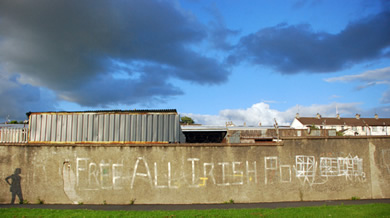An American student's view of the Troubles
Student, San Francisco State University
Dusk has enveloped Cathedral Road in Armagh, and the warm ginger skyline lures the eye towards the twin silhouettes of St. Patrick’s cathedrals at twilight. The seat of ecclesiastic authority for both the Catholic and Protestant churches of Ireland, this city prominently displays symbols which draw the eye and remind visitors that the land of Eire has a troubled past.
Before we arrived I often dismissed the Troubles conflict as provincial, a vicious campaign of fear and discrimination waged by one small group against another. I was sorely mistaken on all counts, except perhaps for the brutality of the violence: between 1969 and 2001 nearly 3,000 Irish citizens and 600 British soldiers perished in the Troubles according to information compiled from Sutton’s Index of Deaths from the Conflict in Ireland, mostly in the small cities and towns of the north. An additional 2,000 citizens were interred without evidence or trial, according to Gillespie’s Chronology of the Troubles.
“Anybody between 16 and 50 that had any sort of republican background at all, they would have been arrested and thrown in jail,” warns Cathy Rafferty, a former IRA prisoner and current councilwoman of Armagh. “People spent seven or eight years in cages without being charged or accused of anything.”
Northern Ireland’s history of conflict is neither neat nor pretty, but it is important for Americans to see the truth behind the Troubles from the perspective of those who lived it. The most valuable thing I learned during my time studying in Armagh was how passionate the people of Ireland are about a conflict that I will never truly understand.
Despite ongoing investigations conducted by organizations like the Conflict Archive and the Belfast Police into the the events of 1969, many in Armagh disagree about how the Troubles began. The city is home to political and religious leaders who have experienced both sides of the conflict, and students expecting to spend any appreciable amount of time there should hear their different opinions on what truly happened.
“The Troubles started here because of discrimination against the Catholic community,” says Armagh councilwoman Mary Doyle, a member of the Sinn Féin party. “People think it was about politics or religion, but really it was about basic human rights.”
As an American journalism student I had been taught to neatly compartmentalize Ireland’s long history of conflict into a political struggle between citizens who wished Ireland to remain independent and those who wanted to join with Britain and the United Kingdoms.
Before I arrived in the city of St. Patrick the role of religion was an afterthought, but after speaking to local administrators it became clear how powerfully the divide between some Catholics and Protestants still affects the city.
“Religion was critical; if it had been a purely political issue, I doubt you’d have had the same degree of violence,” recalls Gareth Wilson, a local DUP councilman and current Deputy Mayor of Armagh. “Once you split a political dispute on religious lines, real hate is fostered in these communities.”
But local religious leaders still administering to the needs of residents who lost friends and family in the violence often suggest that newcomers consider Ireland’s history of religious segregation before coming to a conclusion.
“[The Troubles] started because the Catholic community felt they were being discriminated against, and they wanted basic civil rights,” claims Dean Rooke, chief administrator of the Church of Ireland in Armagh. “What started as peaceful demonstrations became violent demonstrations, which ultimately led to out and out terrorism.”
To this day the verdant hills of Northern Ireland are awash in stripes of white and gold or blue and crimson, the cheerful flapping of a Union Jack or Irish tricolor marking the boundaries between republicans and unionists, Catholics and Protestants, friends and neighbors. Understanding the truth behind the Troubles in Northern Ireland will never be simple, but after a month in Armagh I feel it’s important for students of the world to discover the history of a place from the people who lived it.
Note: The opinions expressed in this commentary are those of the student author and those individuals quoted in the text. They do not necessarily reflect those of iEi Media or any of its faculty, staff or other students.


